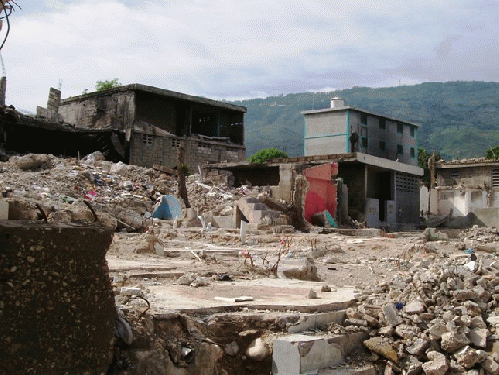********
The Vodou loa of earthquakes is the extremely violent Agau, so violent that when a ritual Vodou practitioner becomes possessed by Agau, it is said, brutality, even death can result, one reason to approach this loa very, very gingerly. It is also said that one who is possessed by Agau may attempt to imitate the sounds of thunder and tremors and may keep repeating, "It is I who am the gunner of god; when I roar the earth trembles." (source)
********
Click here for Part 2
Click here for Part 3
Click here for Part 4
Click here for Part 5
Click here for Part 6
Click here for Part 7
The epicenter of the January 12th, 7.0 magnitude earthquake was Là �ogà ne, some 16 miles west of Port-au-Prince. Needless to say, the capital experienced cataclysmic shocks and damage. According to Wikipedia:
By 24 January, at least 52 aftershocks measuring 4.5 or greater had been recorded. An estimated three million people were affected by the quake; the Haitian Government reported that an estimated 230,000 people had died, 300,000 had been injured and 1,000,000 made homeless. They also estimated that 250,000 residences and 30,000 commercial buildings had collapsed or were severely damaged. (source)
Well, I needed to see this firsthand, so early on Wednesday morning, May 12th, 2010, to continue our series, Andre took me on a tour of as much of downtown Port-au-Prince as I could shoot before we had to get back to the Plaza to grab Georgianne, who was already working furiously on an article in the hotel business center, and then take off for various towns and rendez-vous's to the west of us. Since the Plaza IS downtown, it was really just a matter of someone as knowledgeable as Andre knowing where best to look.So look we did, traveling by car, then parking and jumping out to get closer on foot before moving on to the next locale. I took a lot of shots as we covered a lot of ground, and then we would repeat this exercise the next day, to take in even more of the wounded city. But here are some of the highlights of this first foray:
There are still earthquake refugee tent-cities everywhere in Port-au-Prince, and there will be for a long time, often right off the beaten pathways.
A classic iconic sight on the island is Haitian women gracefully carrying their wares atop their heads.
A sad, all too common sight in Haiti: skinny, even emaciated dogs hunting for food.
Surviving funeral parlors, sardonically speaking, are doing a brisk business since the earthquake.
Thes workers in yellow tee-shirts and hard-hats are enrolled in the government's work for food and pay program, a sort of job corp.
The paint and plaster of the statue of famed revolutionary leader Toussaint Louverture, who led Haitians to freedom and independence against their French slave masters, are in bad need of refurbishing.
Three more women, their burdens atop their heads, weaving their way across the street and onto the square that the statue of Louverture overlooks.
It is hot, very hot in May, so it is a common sight to see street vendors toting and selling ice.
One side of Haiti's infamous national prison, heavily criticized in the past for overcrowding, inhumane living conditions and many injustices in a system made worse after the overthrow of President Bertrand Aristide in 2001. Many of his followers soon ended up here in waves of political repression.
(Note: You can view every article as one long page if you sign up as an Advocate Member, or higher).





